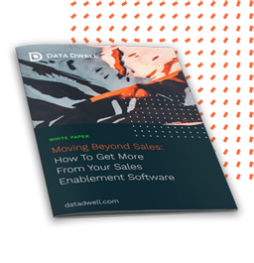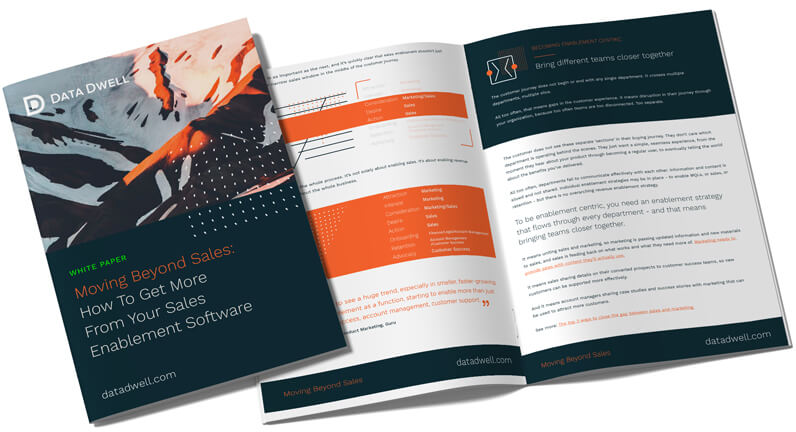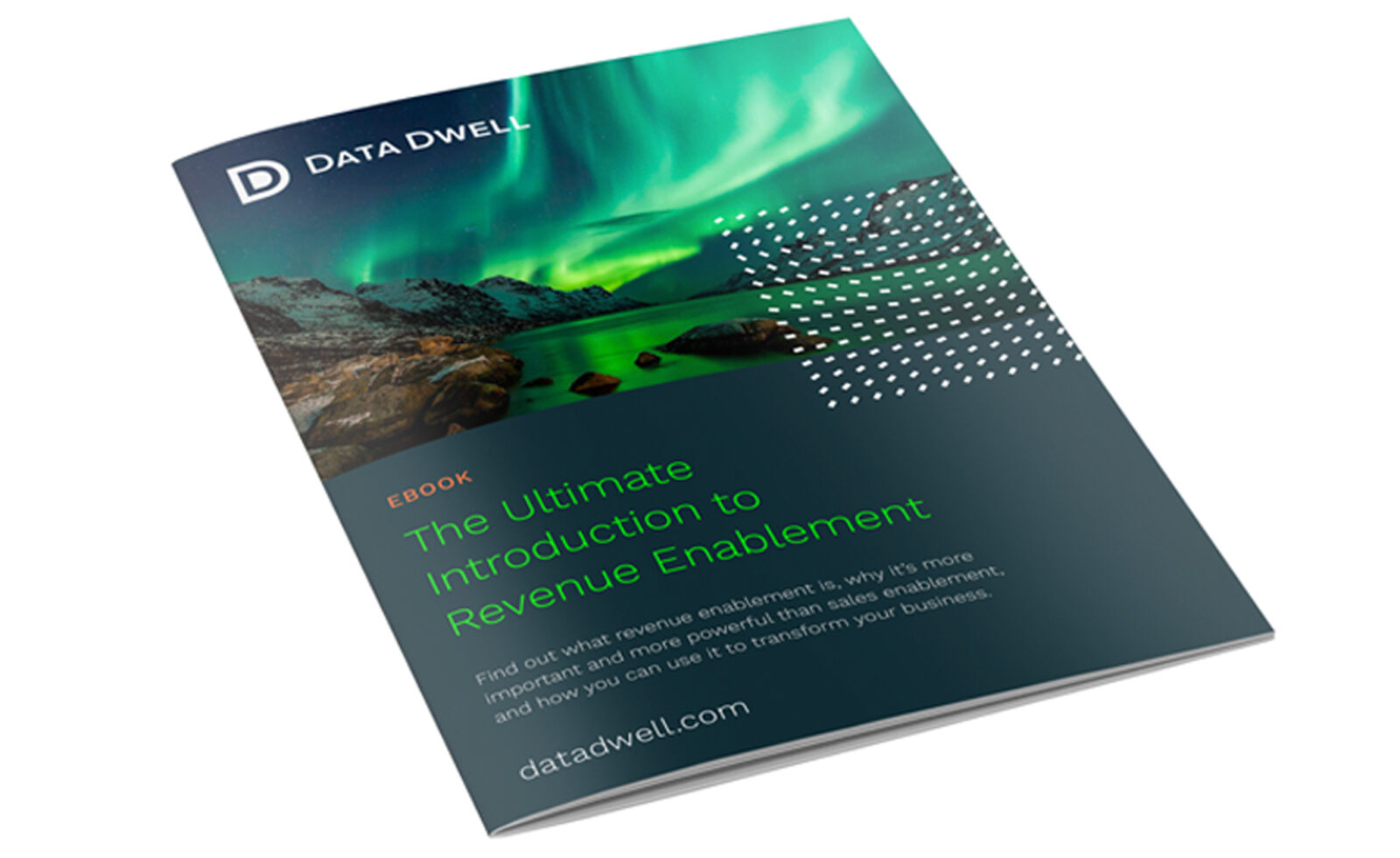
When it comes to sales enablement metrics, there’s no shortage of numbers to focus on.
You’re probably already familiar with ‘the usual suspects’ of sales enablement metrics, because they’re the same figures you’ll track and monitor for any type of sales review. Metrics like sales revenue or quota attainment.
But when you’re using sales enablement software, you’ll want to make sure you’re realizing its full potential. You’ll want to know it’s efficient and effective.
And most importantly, you’ll want to make sure the numbers you’re monitoring are useful. That the figures you see are ones that impact your bottom line and help generate revenue.
Here are our 6 essential sales enablement metrics you can’t afford to miss:
1. Lead to customer conversion rate
If you only measure one sales enablement metric, make sure it’s lead to customer conversion rate. This is a key indicator of whether or not your sales enablement software is proving effective or not.
If your team is using it to engage more prospects and enable more sales, then your customer conversion rate should be increasing.
To calculate your lead to customer conversion rate: divide the number of new customers by the number of new leads in any given period (per month or per quarter).
But that only gives you a headline figure. Useful for a very top-level overview, but not the kind of metrics you’ll be satisfied with if you really want to analyse your sales enablement strategy.
Instead, break down conversion rates for every stage of the customer journey:
- MQL to SQL – to see how marketing and sales are using your sales enablement to work together to generate relevant, sales-qualified leads
- SQL to Opportunity – to track how reps are using content to engage prospects and move them through the funnel
- Opportunity to closed deal – to identify if content positioned with sales enablement software is helping prospects over the final hurdle
- Closed deal to onboarding – to check sales are closing the right leads and ensure customers are moving through the onboarding process (sales enablement software can help here)
- Onboarding to customer success – because your business revenue doesn’t just come from direct sales, and sales enablement software – when used correctly – can help you move beyond sales and drive revenue enablement.
2. Win/Loss rate
Your win/loss rate is another essential sales metric, but it pays to focus on it in the context of your sales enablement strategy too. The number of sales opportunities won (when compared with your pre-sales enablement software rate) should show you how well your software (and your teams’ use of it) is performing.
To calculate your win/loss rate: Add all wins and losses together to get the total number of deals, and then divide your number of wins by the total number of deals.
Win/loss rate will help you calculate other key metrics, like the number of new sales-qualified leads you need, or individual rep quota. And if you track win/loss rate by individual sales reps or sales teams, you’ll see who’s using sales enablement software well and who isn’t.
Dig deeper on win/loss rate figures too if you really want to use them as an essential sales metric and improve your bottom line. Look specifically at competitive deals – those where you’re head-to-head with other, similar providers and where prospects are looking for the right company fit.
Those figures will then help you identify the types of content your sales enablement strategy needs more of to close these competitive deals.
And if you want to move beyond sales, win/loss is a great enablement metric applied to customer retention: How many of your customers are retained beyond an initial period vs. how many leave.
3. Sales cycle time
Our third essential sales enablement metric is sales cycle time (or sales cycle length). If your software and strategy are working as intended, your figures should show a shortened sales cycle.
The shorter the sales cycles, the more deals you’ll close and the more revenue you’ll make. Understanding this metric will help you forecast future revenue more accurately.
To calculate your sales cycle length: count the days between first contact with a prospect to deal closed.
But this sales enablement metric isn’t that simple.
While a shorter sales cycle is typically a positive, that might not be the case with your industry. If you use sales enablement software well, you might find you’re creating more customer touchpoints, with more time spent engaging a prospect.
Done correctly, that will lead to more sales.
The key here is take a granular approach to sales cycle time metrics. Don’t just focus on an average, look at deal types and stage conversions. Take the time to assess why some deals have a shorter sales cycle than others and see if longer cycles actually lead to more conversions.
You should then be able to see:
- which stages of the sales cycle need more sales enablement content
- what campaigns are essential for prospect nurturing
- where sales enablement content can be automated
- which touchpoints increase likelihood of a sale
- If certain sales tactics or content lengthen the sales cycle unnecessarily
All these metrics should then help you speed up and shorten the sales cycles
4. Non-billable sales time
One of the areas which frustrate both sales reps and sales managers is non-billable sales time. Any time spent not selling.
So one way to track the effectiveness of your sales enablement approach is to monitor that non-billable sales time.
Non-billable sales time takes into account all the time reps spend on admin work. That might be searching for content, requesting or making changes to marketing collateral, hunting for answers to prospect questions, or identifying new content they need from marketing.
To calculate your non-billable sales time – track the number of hours sales reps spend selling to customers, and deduct that from their total working hours.
If your sales enablement strategy is effective, the software you deploy should be reducing the time reps waste finding content to share or looking for information they need. It should be at their fingertips so they can spend more time selling.
5. Onboarding time (New customers AND new reps)
The time it takes for a new customer to move through your onboarding process is a great indicator of how well your sales enablement strategy is performing, especially if you’re moving beyond sales and using enablement software to support customer success.
The faster your new customers complete onboarding and become active users, the more effective your sales enablement is because it indicates they know what to expect. They are aware of what the product or service is, they know how to use it and they’re confident they’re on the right path.
Put another way, a faster onboard time shows that content (like how to guides, user manuals and case studies) has been positioned effectively throughout their customer journey.
Onboarding time is a metric that should be applied and tracked with new sales reps too – often known as ‘ramp time’.
Ramp time is an extremely useful metric to see how well your new sales reps are getting up to speed on your organisation and your products, and how quickly they can start selling effectively.
If you have an effective enablement program in place, it will position training content efficiently to bring reps onboard quickly.
To calculate your ramp time: determine a quota when you consider a new rep to be selling at 100% and calculate the time it takes from their first day up until they reach that quota.
The better your sales enablement training program, the shorter the ramp time.
By increasing training content and positioning it more effectively, you won’t just reduce ramp time. You’ll also reduce the amount of time managers spend coaching and supporting new hires, leaving them free to focus their actions on driving sales elsewhere.
6. Deal Size
Not all deals are created equal, which is why our final essential sales metric to track is deal size.
An effective sales enablement strategy shouldn’t just help your sales reps sell more. It should help them sell to more prospects (beating their quotas) and sell more to each of those prospects. It should see them increasing the size of deals (both in terms of revenue and contract length).
A good sales enablement approach will see marketing and sales working together to attract more lucrative prospects and position content that will upsell and cross sell products and services – increasing average deal values.
To calculate average deal size – simply add all your deal values from a set period together and divide by the total number of deals. Then compare with the previous period or year.
Tracking deal size will help you see how sales enablement is:
- Building closer prospect relationships
- Deepening need awareness in prospects
- Positioning your solutions more effectively
- Generating higher value deals
And when you know what these deal size metrics are, you can identify ways to increase them.
Deal size is an extremely useful sales metric to track because it can be used to help your organization shift their mind set from sales enablement to revenue enablement. One key step to moving beyond sales and getting more from your sales enablement software is to look at ways to increase your customer value.
If you can sell more to a customer post-conversion – through cross selling and upselling during customer success or customer retention efforts – you’ll be increasing the overall deal size for that customer (and using sales enablement software more effectively!)
Six essential sales metrics to track – but there’s plenty more to monitor
Tracking these six sales enablement metrics will help you instantly assess how well your sales enablement strategy has been deployed and whether or not you’re using your software effectively.
But they’re just the tip of the iceberg. There are many different types of metrics you’ll want to track, depending on your organization’s approach and priorities.
If the numbers aren’t looking good, or if there are some metrics you can’t track, it might be time to switch to more effective sales enablement software like Data Dwell. One that helps you position content across departments and enable every team to sell more effectively – driving revenue for the whole business.




